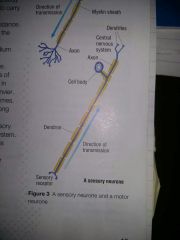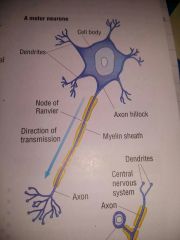![]()
![]()
![]()
Use LEFT and RIGHT arrow keys to navigate between flashcards;
Use UP and DOWN arrow keys to flip the card;
H to show hint;
A reads text to speech;
21 Cards in this Set
- Front
- Back
|
Acetylcholinesterase |
Enzyme within the synaptic cleft that break down the transmitter substance acetylcholine. This stops the transmission of signals |
|
|
Acetylcholine |
Transmitter substance that diffuse across the synaptic cleft |
|
|
Transmission across the synase |
1.An action potential arrives at the synaptic knob 2.The voltage-gated calcium ion channels open 3. Calcium ions cause the synaptic vesticles to move to and fuse with presynaptic membrane 4. Acetylcholine is release by exocytosis and diffuses across the clef 5.acetylcholine molecules binds to the receptor sites on the sodium ion channels in the postsynaptic knob 6.sodium ion channels open and sodium ions diffuse a across the postsynaptic membrane into the postsynaptic node 7.generator potential or excitatory potential is created 8.if suffient generator potential combinr the potential across the postsynaptic membrane reaches the thershold potential 9. A new action potential is created in the postsynaptic neurone |
|
|
Structure of cholinergic synapse |
Synaptic node many mitrocondrion vesticle of chemical transmitters voltage-gated calcium ion channels Postsynaptic membrane specialise sodium ion channels which have special receptors which are complementary to transmitters |
|
|
Myelin sheath |
soduim and patassium ions cannot diffuse through the fatty layer swchann cells gaps = nodes of ranvier |
|
|
Saltory condition |
Refers to they way that the action potential appears to jump from one node of ranvier to the next |
|
|
Local current |
1. Sodium ion channel open allowing sodium ion to diffuse into the neurone 2. Localised increase in concentration of sodium ions inside neurone, the action potential 3. Sodium ions diffuse along the axon, away from the region of higher concentration 4. Soduim gate which were initicially closed open because of the movemet of sodium ions allowing the action potential to move along the nerone |
|
|
Sensory nerones |

|
|
|
Motor neurones |

|
|
|
Sensory receptors roles |
Detect change in enviroment Energy transducer covert on form of energy to another |
|
|
Ionic movement |
1. The membrane starts at resting potential it is polarised with the inside of the cell 60mv 2. Soduim ion channels open and sodium ions diffuse out of the cell 3. Membranes depolarise, the inside become less negative and reaches the therahold value of -50mv 4.voltage-gated sodium channels open and many sodium ions diffuse into the cell 5. The potential difference across the plasma membrane reaches +40mv (inside more postive compared with the outside) 6. Sodium ion channels close and patasium ions channels open 7. Patassium ions diffuse out of the cells this is calle depolarisation 8. The potential difference overshoots slightly, makin the cell hypolarised 9. The orignal potential is restored |
|
|
Refactory period |
Short period where it is impossible to stimulate action potential. Allows cell to recover after action potential and ensures it is transmitted in one direction |
|
|
All or nothing |
Genrator potential in sensory receptors are depolarisations of the cell membrane Depolarisation much be large enought to reach thershold potential for action potential to be transmitted |
|
|
Acclimatisation |
Repeated stimulation a synapes runs out of vesticle containing the trasmitter substance |
|
|
Summation |
Low-level signals can be amplified. Stimulus is persistent |
|
|
Several presynaptic |
Converfe to one postsynaptic neurone |
|
|
One presynaptic neurone |
Diverge to serveral postsynaptic neuronr |
|
|
Synapes |
Ensure that the signals are transmitted in the correct direction Only presynaptic knob contaibs vesticles of acetylcholine |
|
|
Unwanted low signals |
Can be flitter out. |
|
|
Frequency |
Higher intensity signals the sensory receptirs produce more generator potentials. Action potential is more frequent. When arrived at the synapse they cause more vesticles to be released. Brain determined the intendity of the stimulus from the ferquency of signals arriving. |
|
|
Myelinated and non-mylinated neurones |
Myelinated schwann cells are wrapped around the neurones intervals 1-3mm (node of ranvier) node is very short typical speed 100-120ms (rapid reponse to a stimulus) sensory receptor to CNS and from the CNS to effectors carries signald over long distances Non-myelinated one loosly wrapped schwann cell 2-200ms shorter signals carried over short distances coordinated bodly functions |

